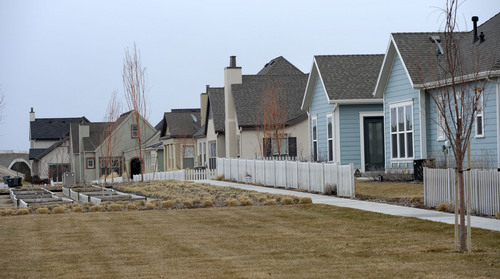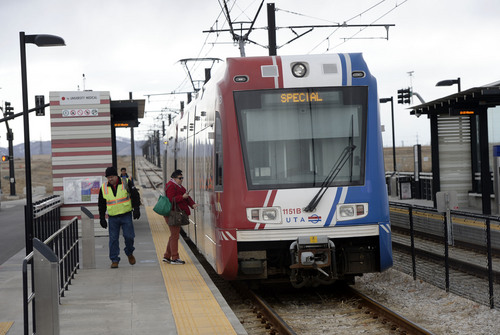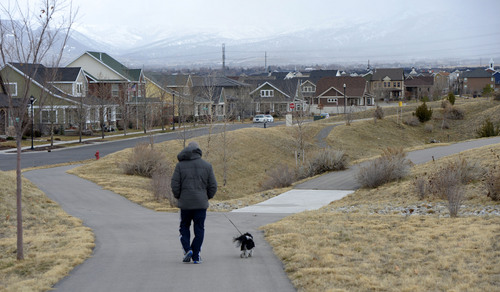This is an archived article that was published on sltrib.com in 2014, and information in the article may be outdated. It is provided only for personal research purposes and may not be reprinted.
South Jordan • One of Salt Lake County's major polluters also has a powerful model for improving air quality along the Wasatch Front.
Kennecott Utah Copper is now 10 years into a quiet experiment in urban planning unlike any other in Utah, a meticulously laid out residential development in South Jordan known as Daybreak. Integral to its vision: Getting people out of their cars.
As much as half of polluting emissions that hang over Utah's most populated counties during winter inversions spew out of vehicle tailpipes.
Tucked away on the county's southwest corner at the foot of the Oquirrh Mountains, Daybreak is built around an intricate master plan with the central, sprawl-busting goal of reducing reliance on driving.
The Wasatch Front may have a lot to learn from the Daybreak model in this regard, as it continues to cope with population growth and urban expansion putting more vehicles on its highways every day. But will residents elsewhere adopt its model?
Walkability is built into every facet of Daybreak's complex sustainable design. Its higher housing density, smaller yards, space-saving home floor plans and lot designs, neighborhood clustering around retail centers, embrace of mass transit and extensive trail systems all significantly cut miles driven.
"When people can buy homes closer to transit or be in a neighborhood that gives them the option to walk," said Ty McCutcheon, Daybreak's general manager and vice president of Kennecott Land Company, "the cumulative effects of that are huge."
The community, built by Kennecott with backing from its London-based parent company Rio Tinto, is closely woven with mass transit. As Utah Transit Authority broadens its reach on the Wasatch Front, other communities around light rail and bus lines are learning from Daybreak's examples for transit-oriented development.
"It's a really good demonstration model of what can be done," said Robert Grow, founder of Envision Utah, a regional planning group that 15 years ago helped to develop many of the walking-centered ideas underlying Daybreak's plan.
Kennecott's land managers helped lure a red line extension of TRAX light rail into the project by paying a share of environmental study costs. A few years later, westbound TRAX trains terminate on specially designed Daybreak platforms, right next to a sparkling new University of Utah Medical Center and campus. The park-and-ride lot is all but full on weekdays.
Since it opened the first clusters of homes in what's envisioned as a 4,127-acre site, Kennecott's foray into community building has proved popular with home buyers. Many cite walkability and access to TRAX as major factors in their purchase.
They also cherish Daybreak's network of trails winding throughout a web of interlaced parks and the short walk to schools, community attractions and features such as SoDa Row, Daybreak's expanding retail cluster.
Zakia Richardson is a New York native who lives in Daybreak's East Lake Village with her husband and two elementary school-age kids. The children walk to school daily. The family hikes, bikes and also canoes on Oquirrh Lake come summer.
"I love the community,'' Richardson said. ``I love what it offers, not only for myself but also my family."
Twitter: @Tony_Semerad —
Daybreak: Answers to air pollution?
Daybreak is a residential and mixed-use development in South Jordan, built on a restored mine waste site by Kennecott Utah Copper and its parent company, London-based mining conglomerate Rio Tinto. Begun in 2004, Daybreak follows a master plan based on sustainable land use, intended as a model for growth challenges faced across the Wasatch Front. —
Join the conversation
The Salt Lake Tribune seeks your input on stories about Daybreak and the lessons Utah can learn from it regarding air quality.
We're interested in your views on aspects of the South Jordan community and your neighborhood, on pollution-reducing ideas such as walkability, housing density, clustered neighborhood layouts, green spaces, access to mass transit as well as energy efficient homes.
This story focuses on development strategies to slash vehicle miles driven, a top source of emissions in our winter inversions. Future stories will deal with making homes less polluting and the role of industrial polluters such as Kennecott.
What are your ideas for addressing Utah's air quality problems? Share comments, insights and experiences by emailing utairquality@sltrib.com. Please include your name and contact information.







